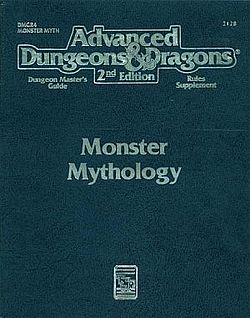- Monster Mythology
-
Monster Mythology 
Author(s) Carl Sargent Genre(s) Role-playing game Publisher TSR Publication date 1992 Monster Mythology is a sourcebook for the second edition of the Dungeons & Dragons roleplaying game. Released by TSR in 1992 and written by Carl Sargent, with interior illustrations by Terry Dykstra, John and Laura Lakey, and Keith Parkinson, Monster Mythology was released as a companion volume for Legends & Lore. This book contains detailed information on the societies, cultures, myths, and deities of several non-human pantheons, including those of the elves, dwarves, gnomes, halflings, orcs, goblins, dragons, giants, drow, and many other creatures.
Contents
Introduction
The book begins with a 12-page introduction, on pages 4-15. It describes the fact that this book follows a similar format to 2nd edition Legends and Lore, except that while that book dealt with nine historical and two fictional human cultures, Monster Mythology deals with nonhuman pantheons. Unlike the culture-specific gods in Legends and Lore, the gods in this book are for any campaign setting. Approximately 26 of the deities found in Monster Mythology were previously found in the first edition Deities and Demigods book, while the majority did not.
The introduction has several sections after the lead. Running Divine Beings provides notes for the Dungeon Master on how and when deities interact with the world and their followers. Deities and the Campaign describes the place of deities within a campaign. Divine Abilities details the abilities that all deities have in common, as well as those of the four tiers of power: Greater God, Intermediate God, Lesser God, and Demigod. This section also describes how many avatars (manifestations of the deity upon the Prime Material Plane a god of a certain power level may have, and how many spells and special powers a god can grant followers based on power level. Nonhuman Deities as Archetypal Powers describes how the deities in the book are archetypal (as opposed to the ones in Legends and Lore which do not appear in every campaign), and do not vary greatly from world to world. Integrating Human and Nonhuman Pantheons suggests how human and nonhuman deities may coexist in the same game world. Avatars gives specific details on how avatar statistics work, based on those given for each deity in the book. Priests and Priesthoods explains how this section found in each deity entry is intended to function. Deities Included in This Book explains why the deities in this book were chosen to appear here. Explanatory Notes explains the mythos section introduction given before each pantheon is presented, and the personal entries of each god therein. Lastly, Abbreviations explains the abbreviations used in each deity entry.
The Gods
Pages 17-125 describe the 131 divine beings found in this book. This is divided up into eight mythos sections, each containing a different number of deities. As described in the Introduction, each mythos has two or more pages of introduction to the pantheons therein as a whole, and includes some information on the pantheons' history and how each deity interacts with the others.
The personal entry for each deity is usually one column in length (half page), though some take up two columns (full page). Each entry includes one or more paragraphs of descriptive text to indicate what sort of deity it is, followed by a brief statistics line (describing the deity's alignment, the most common alignment of its worshippers, the god's area of control, and a description of the god's symbol). Each section also describes the god's avatar and priesthood, as noted in the Introduction.
The following beings are detailed in Monster Mythology:
Gods of the Demihumans
Gods of the Elves
- Labelas Enoreth
- Solonor Thelandira
- Lafarallinn
Gods of the Dwarves
Gods of the Gnomes
Gods of the Halflings
- Urogalan
- Kaldair Swiftfoot
Goblinoid Deities
Gods of the Orcs
Gods of the Goblins
- Maglubiyet
- Khurgorbaeyag
- Bargrivyek
Gods of the Bugbears
Gods of the Kobolds
- Gaknulak
Other Goblinoid Deities
Gods of the Underdark
Gods of the Drow
Gods of the Underdark Dwarves
The Lost Gods
- The Elder Elemental God
- The Dark God
Gods of the Illithids
- Maanzecorian
Gods of the Myconids
- Psilofyr
Gods of the Beholders
Gods of the Svirfnebli
Gods of the Giants
The Giant Gods
The Interloper Gods
Gods of the Seas and Skies
Gods of the Scaly Folk
- Blibdoolpoolp
- Laogzed
- Merrshaulk
Gods of the Dark Folk
The Sylvan Gods
- Eachthighern
- Emmantiensien
- Fionnghuala
- Nathair Sgiathach
- Skerrit
- Squelaiche
- Verenestra
- Queen of Air and Darkness
Appendices
Appendix 1: Avatars in Game Play
This section gives some further tips for how avatars may be developed in play, such as where an avatar might make its home, when it might become a patron of a group of adventurers or take on an adventurer as a sidekick, require rescue, lose a magic item, need to be found by player characters, or become enamored with a mortal character.
Appendix 2: Deities and Game Worlds
This short appendix gives references where a Dungeon Master may find 2nd edition Advanced Dungeons & Dragons details on the deities of specific game worlds, such as the Forgotten Realms, Greyhawk, Dragonlance, and Dark Sun.
References
- Sargent, Carl. Monster Mythology (TSR, 1992).
Review: White Wolf #36 (1993)
Categories:- Dungeons & Dragons books
Wikimedia Foundation. 2010.
